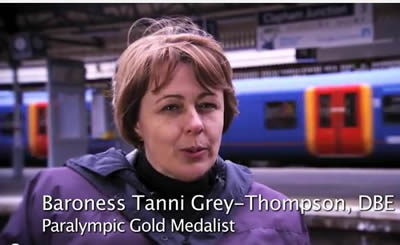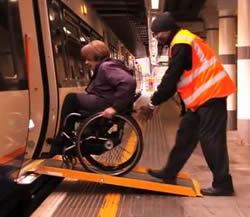London Overground Becomes "Turn Up and Go" for Disabled Customers
Paralympian gold medallist Tanni urges Londoners to use service
Paralympian gold medallist Baroness Tanni Grey-Thompson has launched the new "Turn up and Go" service on TfL's London Overground rail network, which means that disabled people needing assistance can simply arrive at stations and have staff help them without being asked to book in advance.
This includes local Overground stations at Shepherd's Bush, Olympia, West Brompton and Imperial Wharf on Fulham's riverside.
And Tanni is urging disabled Londoners to take advantage of Transport for London's increasingly accessible network and to make the most of all the city has to offer.
The disabled rights campaigner said : " TfL really are now leading the way in accessible transport.
" While it isn't perfect and many stations were built in an era when accessibility wasn't even considered, all London buses, taxis, the whole DLR and large parts of the Tube and now London Overground networks are accessible to disabled customers, including wheelchair users.
" As of today, the entire London Overground network is 'Turn Up and Go', which has long been an issue for me.
" I would urge other rail companies to follow suit.
" For me, TfL have another brilliant asset, which is their staff who will be visible and available to help and advise all customers. In future, London Underground will have more staff in ticket halls, on gate lines and platforms to help all customers, including disabled Londoners and visitors.
"So, if you're tempted to stay at home when actually you want to get out, don't. Come on board and make the most of all this great city has to offer."
Gareth Powell, Director of strategy, London Underground & London Rail said: " We're committed to making the TfL network truly open to everyone.
" Inevitably, given the often Victorian infrastructure of much of our network, this is going to take some time. But where we can make improvements quickly we are, as on the London Overground today.
"We believe our staff are key to making our network truly inclusive, which is why we're investing in staff training programmes so that really anyone can turn up at our stations, or stops, and rest assured they're going to receive all the help they need."
To help reinforce her point, Baroness Grey-Thompson, who is a member of the TfL Board, has produced a video which can be seen here.

It is part of a wider TfL campaign to raise awareness of accessibility improvements on the transport network.
Her call comes as an independent survey revealed that, despite a raft of improvements in recent years, only around a fifth of the capital's one million disabled people are using the Tube.
However, the study also showed more than two fifths (43%) of disabled passengers thought transport in London was becoming easier to use for them.
The Mayor and TfL are investing in and delivering a huge range of improvements to improve accessibility across TfL's road, rail and bus networks, embedding the legacy of accessible travel promised by the 2012 Games. Improvements include:
25 more London Underground and London Overground stations to become step-free over the next ten years, as well as dozens of National Rail stations and accessible Crossrail stations in the heart of the city. TfL expects the number of journeys made by step-free routes each year will almost treble, from 77 million at present to 227 million in 2023
A £250 million investment in step-free projects at stations including Bond Street, Greenford, Tottenham Court Road, Vauxhall, Victoria and Finsbury Park.
75% of all London bus stops to be fully accessible by April this year, with at least 95% fully accessible by the end of 2016, bringing even greater ease of use to a bus network that is already the most accessible in the country.
On-board audible and/or visual announcements are used across our bus and rail networks to help people with sight and/or hearing loss>
The remaining five% of pedestrian crossings yet to be brought up to accessibility standards to be upgraded with tactile paving, rotating cones or audible alerts. A total of 39 sites will be upgraded by March, with 100% to be accessible by 2016
Further improvements include permanent level access at new stations, permanent raised platform sections, low-floor trains and boarding ramps making getting around the network much easier.
By 2016, a third of Tube platforms will have level access by one of these means, up from 15% last year.
TfL adds that more step-free projects are being progressed with third party developers and additional stations are being made partially step-free.
March 17, 2014
Related links
|
